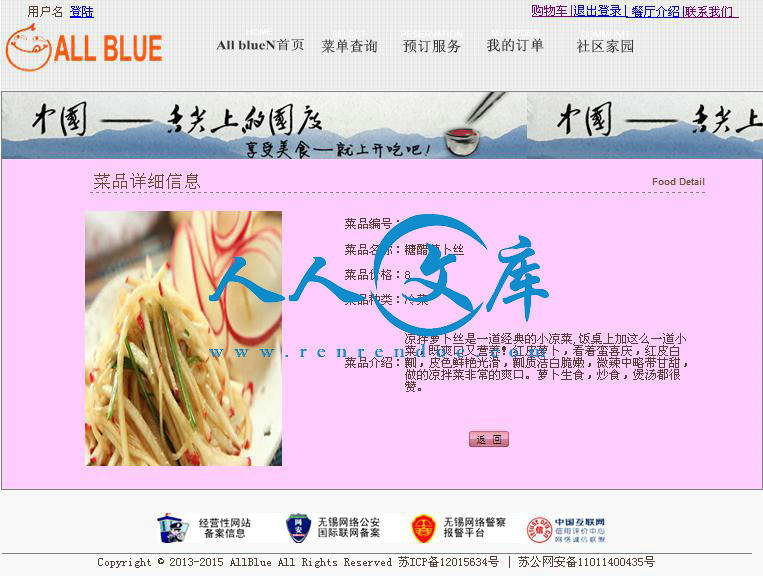基于.NET的在线订餐系统设计与开发
65页 23000字数+说明书+任务书+开题报告+在线订餐系统代码
任务书.doc
在线订餐系统代码.rar
基于.NET的在线订餐系统设计与开发开题报告.doc
基于.NET的在线订餐系统设计与开发论文.doc
外文翻译--ASP.NET技术.doc
相关资料.doc
计划周记进度检查表.xls
摘 要
随着计算机网络技术的不断发展,网络已成为人们日常生活的一部分。越来越多的人喜欢上了网购这种便捷的方式,因此在线订餐也受到了人们的欢迎。本系统分为两大模块:前台模块和后台模块。前台登录模块主要实现了用户注册、用户登录、找回密码的功能。用户登录后能够对菜品进行查询、预定、加入购物车、订单、支付、退款。用户在我的订单下可对订单进行查询、个人资料的修改。用户在社区家园里可以进行留言并查看他人留言。在后台模块中,普通管理员能够查看用户信息,查询并回复用户留言,对菜品详细信息、菜品类型进行查询及增删改,对用户订单可查询及批量删除,还可实时更改公告栏信息。超级管理员除了上述操作外,还能查询所有管理员信息,增加或删除某个管理人员,修改管理员权限。
经过分析,本系统使用Visual Studio 2005和SQL-Server2000作为开发工具,开发出了以B/S为模式的基于ASP.NET的在线订餐系统。
关键词: ASP.NET;在线订餐系统;SQL-Server;Visual Studio
目 录
摘 要III
AbstractIV
目 录V
1 绪论1
1.1在线订餐系统的研究内容和意义1
1.2国内外订餐系统的发展概况1
1.3在线订餐系统应达到的要求1
1.4开发环境2
1.5本文主要内容2
2相关技术介绍3
2.1 ASP.NET技术3
2.2 SQL Server 2000介绍4
2.3 C#语言5
2.4 B/S结构6
2.4 本章小节6
3在线订餐系统分析7
3.1 可行性研究7
3.2 需求分析8
3.2.1 功能需求分析8
3.2.2 数据库需求分析8
3.2.3 数据流图9
3.2.4 数据字典11
3.3 流程图12
3.4 本章小节12
4 在线订餐系统总体设计13
4.1 系统模块图13
4.1.1前台功能模块13
4.1.2 后台功能模块14
4.2 数据库设计15
4.2.1 数据库概念设计(E-R图)15
4.2.2 数据库逻辑设计17
4.2.3 数据库物理设计21
4.2.5 数据库关系图22
4.3 本章小节22
5在线订餐系统的实现23
5.1 前台系统的实现23
5.1.1 在线餐系统首页23
5.1.2 菜单查询与菜品详细信息界面24
5.1.3 预订服务界面26
5.1.4 我的订单界面30
5.1.5 社区家园界面36
5.1.6 用户登录与注册界面38
5.2 后台系统的实现43
5.2.1 登录界面43
5.2.2 用户管理43
5.2.3 菜品管理45
5.2.4 订单管理界面46
5.2.5 管理员管理47
5.2.6 公告栏界面47
5.2.7 留言板界面48
5.3 本章小节48
6系统测试49
6.1 测试方案49
6.2 测试过程49
6.3 本章小节49
7 结论与展望51
7.1 结论51
7.2 不足之处及未来展望51
致 谢53
参考文献54
附 录55
1.2 国内外订餐系统的发展概况
现在我国多数餐厅使用的订餐方式仍是电话订餐。然而这种订餐方式存在着许多的不足,如效率低,需人工记录,而且容易遗漏和出错。因此在线订餐的出现顺应了时代的需求。当然也有商家发现了新的市场开发网上业务。近几年来国内在线订餐发展迅速,因为在线订餐模式的成本低,又有巨大的市场,从事在线订餐的网站如雨后春笋般的出现。由于国内关注在线订餐的人数有限,而且比较集中在白领、大学生等青年群体中,以一线城市为主要市场,区域性比较明显。所以总体来说,我国的在线订餐业务才刚刚起步,仍然存有很大的发展空间。
国外的许多知名餐饮企业在多年前就已经开始了出现网上订餐服务,并且受到了许多人士的欢迎。最近几年网上订餐服务也在中国陆续推出、逐渐普及。
1.3 在线订餐系统应达到的要求
⑴ 说明在线订餐的指导思想;阐述在线订餐系统应解决的主要问题。
⑵ 用户可以进行多条件查询,根据具体需要方便、迅速的找到所需信息。
⑶ 系统中的信息采用动态式发布,信息的发布更新的实时。且在线订餐采用动态网页技术实现内容发布。
⑷ 系统要有良好的互动性,方便用户提供建议与意见。
⑸ 系统要有清晰的构架、友好美观的界面。
1.4 开发环境
⑴ 服务器端
操作系统:Windows XP
数据库服务器:SQL Server2000
浏览器:IE浏览器
⑵ 客户器端
浏览器:IE浏览器
1.5 本文主要内容
本文通过需求分析对在线订餐系统进行总体规划,开发出一个基于B/S模式的在线订餐系统。本在线订餐系统按照软件工程的基本步骤进行系统分析、设计和实现。本文的具体结构安排如下:
第一部分绪论主要阐明在线订餐系统的研究内容与意义,国内外的订餐系统的发展状况,以及系统应达到的要求。
第二部分主要内容是相关技术的介绍,介绍了系统开发工具的优势所在。
第三部分是对软件进行可行性分析与需求分析,分析了系统要达到的主要功能等。给出了系统的整体流程图。
第四部分主要是系统模块设计和数据库的设计,描述了系统前后台的主要模块,数据库概念设计、逻辑设计和物理设计。
第五部分主要讲述了在线订餐系统的实现,前后台的主要界面和代码。
第六部分对系统实现功能的测试,
第七部分是对本文的结论和展望,总结了完成本系统后自己的感悟与系统存在的不足之处。
最后,感谢对于在完成这次论文与软件过程中给予帮助的人,列出参考文献。

 川公网安备: 51019002004831号
川公网安备: 51019002004831号